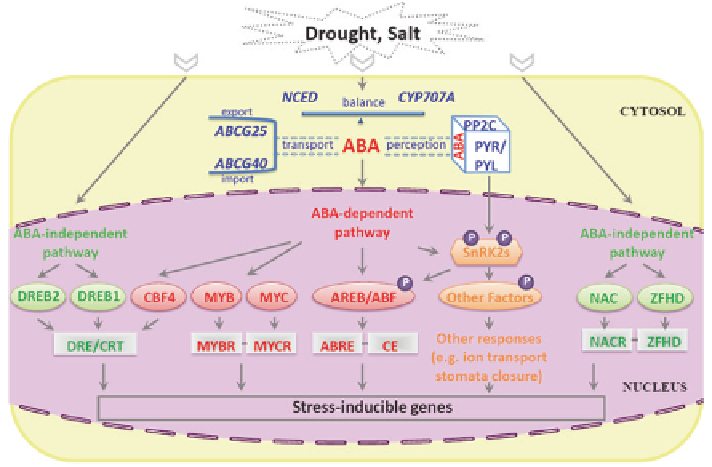Agriculture Reference
In-Depth Information
Fig. 16.1
A model for abscisic acid (ABA)-involved responses to drought and salt stresses in
Arabidopsis
. Drought and high salinity induce increased levels of endogenous ABA, which is
regulated by the balance of ABA biosynthesis and catabolism mediated by
NCED
and
CYP707A
genes, respectively. The increased endogenous ABA levels result in the formation of the ABA-
PYR/PYL-PP2C ternary complex. This complex activates SNF1-related protein kinase 2
(SnRK2s) to phosphorylate downstream components in response to cell dehydration, leading
to ion transport and stomata closure, expression of stress-responsive genes, etc.
ABCG25
and
ABCG40
, as major ABA transporters, play central roles in response to drought and salt stresses.
Transcription regulatory circuit of major cis-acting elements, transcription factors responding
to drought and high salinity in cell nuclei are shown in the light purple region. Transcription
factors involved in regulation of stress-inducible gene expression are shown as colored ellipses.
Cis-acting elements are shown in gray boxes. Small deep purple circles reveal phosphorylation
modifications of transcription factors in response to stress signals. SnRK2s are shown in the hex-
agon. Red and orange characters represent the transcription regulatory circuit that responds to the
drought and salt stresses in an ABA-dependent manner. Green characters represent the transcrip-
tion regulatory circuit in response to stress conditions through an ABA-independent pathway.
(Figure is modified from the following sources: Miyakawa et al.
2013
; Nakashima et al.
2009
;
Roychoudhury et al.
2013
; Umezawa et al.
2010
).
genes are also induced by drought, indicating extensive overlapping mechanisms
between drought and salt stresses (Roychoudhury et al.
2013
). Both stresses can
induce cellular dehydration, causing osmotic stress that triggers the biosynthesis
and increases the endogenous levels of the phytohormone abscisic acid (ABA).
Conversely, exogenous application of ABA induces many genes that normally
respond to drought and high salinity (Shinozaki et al.
2003
; Zhu
2002
). ABA con-
trols stress adaptation responses and regulates water balance and is the most stud-
ied stress-responsive hormone (Peleg and Blumwald
2011
). In this chapter, we
will examine the roles of ABA in tolerance resulting from drought and salt stresses
using the probable working model shown in Fig.
16.1
.

Search WWH ::

Custom Search